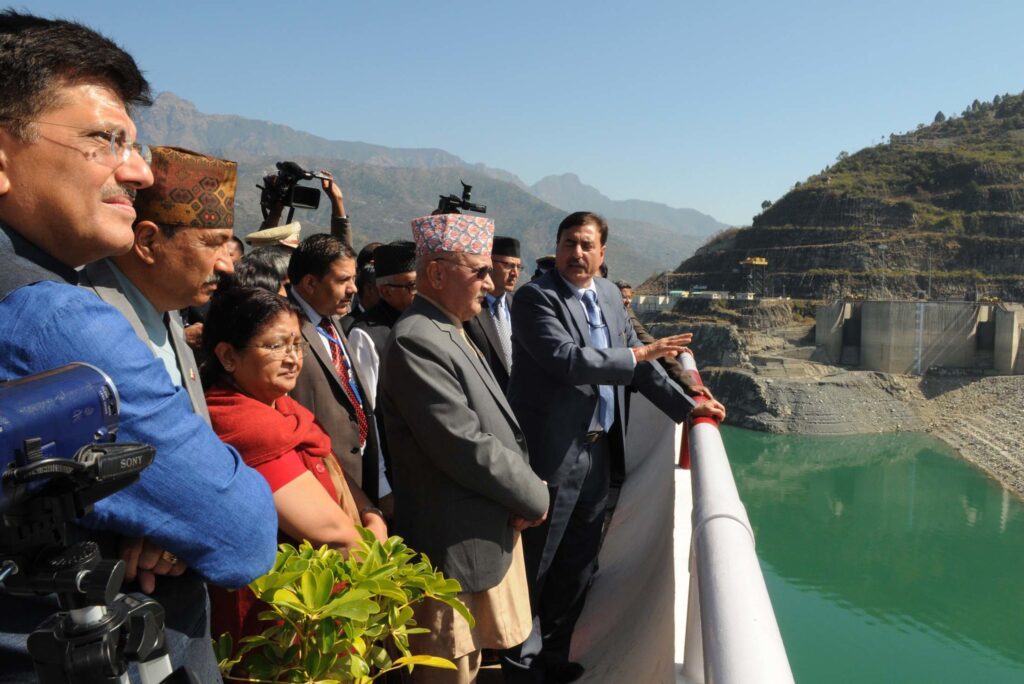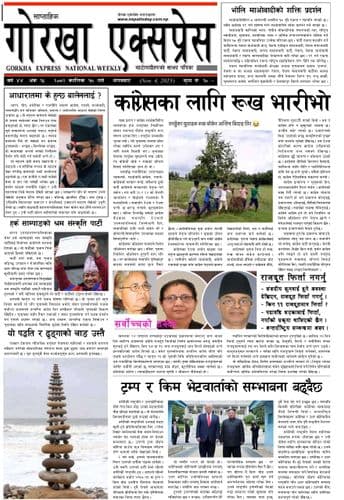
Gaurab Shumsher Thapa - - - -
Nepal recently ushered in its fourth government with different combinations of parties since the December 2022 parliamentary elections when the Communist Party of Nepal (Unified Marxist Leninist) (CPN (UML)) chair K. P. Sharma Oli was sworn in as the Prime Minister on July 15. The perennial instability in Nepal’s domestic politics erupted again when the CPN (UML) withdrew its support to the previous government led by Pushpa Kamal Dahal ‘Prachanda’ of the Communist Party of Nepal (Maoist Center), and CPN (UML) and the Nepali Congress, two of the largest political parties in the country, joined hands to form a new government. Meanwhile, Nepal watched closely as the Indian parliamentary elections brought Prime Minister Narendra Modi back to power for the third time in June.
With new governments in both countries, it is pertinent to examine how relations between these two neighbors are likely to progress. While the Bharatiya Janata Party’s (BJP) majority has weakened, continuity is expected in the Indian government’s Nepal policy. However, frequent changes in Nepal’s domestic politics cannot guarantee a steady course for its foreign policy. At the same time, such a factor should not be allowed to affect bilateral ties. Given that India is an immediate and close neighbor, the new Nepali government under Oli should lay the groundwork for revitalizing its foreign policy and diplomacy with regards to New Delhi. By accelerating ongoing economic collaboration, addressing policy irritants, and creatively navigating overarching strategic differences, Nepal can leverage its bilateral relationship with India during Modi’s third term to achieve the developmental gains it hopes for.
Refocusing Ties and Removing Policy Obstacles
As Nepal looks to rebuild its economy post the pandemic and regain a balance in its regional relationships, India becomes an important partner. India is Nepal’s largest trading partner and source of the highest foreign direct investment and tourism. For New Delhi too, deepening cooperation with its immediate neighbor and steering ties towards its best interests is beneficial, given other countries vying to expand their influence in the neighborhood. To do so, Kathmandu and New Delhi would have to make concrete progress on existing areas of cooperation such as hydropower, resolve outstanding irritants in their bilateral relationship – including recruitment of Nepali Gorkha soldiers into the Indian army, and their territorial disputes – and identify new avenues of cooperation to cement ties.
Water is Nepal’s strategic asset. And as one of the fastest growing economies in the world, India has immense energy needs. Thus, hydropower generation is a key mutual area of cooperation for both countries. During Nepali Minister for Foreign Affairs Arzu Rana Deuba’s recent visit to New Delhi, both sides announced that India would be importing an additional 251 megawatts (MW) of electricity from Nepal – amounting to nearly 1000 MW in total electricity flows from Nepal to India. The two major joint hydropower projects between the two countries are the 900 MW Arun-3 and the 900 MW Upper Karnali projects. Additionally, both countries have signed a memorandum of understanding to develop the 480 MW Phukot-Karnali project and entered into a power development agreement to construct the 669 MW Lower Arun hydropower projects. However, many of these projects are plagued by delays. In fact, the Pancheshwar Multipurpose Project has been pending for decades due to differences between the two sides on modalities of implementation. Kathmandu should investigate and act on the delays in these projects, prioritizing their completion as soon as possible, especially since India may not be motivated to purchase electricity from Nepal in the long term due to its growing focus on solar energy domestically. Another challenge is isolating projects from geopolitical impact–for instance, India has apparently communicated concerns regarding purchasing electricity produced from Nepali hydropower projects that have direct Chinese investment. Kathmandu would have to find some compromise with New Delhi to remove such barriers.
By accelerating ongoing economic collaboration, addressing policy irritants, and creatively navigating overarching strategic differences, Nepal can leverage its bilateral relationship with India during Modi’s third term to achieve the developmental gains it hopes for.
A symbol of the historical linkages between India and Nepal is that Nepali nationals serve in the Indian army. However, recruitment of these Nepali Gorkha soldiers in the army through the new Agnipath scheme has stalled since 2022. Nepal has opposed the new provisions that would lead to a shortened career for a soldier, compounding the already severe unemployment scenario in the country. Nepal also suspects that the early-retired soldiers could be vulnerable to being lured by non-state actors. Kathmandu wants the recruitment as per the provisions set in the 1947 Tripartite Agreement between India, Nepal, and the United Kingdom. The new Nepali government should take up the matter with the Indian government to find a logical solution to this problem.
While there is much untapped potential in Nepal-India ties, their territorial dispute flares up from time to time and threatens to mar any progress. Since 2020, Nepal and India have been embroiled in a row involving the territories of Kalapani, Lipulek and Limpiyadhura. Nepal published a political map containing these territories in response to India’s publication of a new map in November 2019 illustrating Kalapani as its territory as well as its opening of a road connecting Lipulek to Tibet in May 2020. These strategic areas, which include the Nepal-India-China trijunction, are under Indian control but claimed by Nepal as its own. Due to the complex and sensitive nature of this matter, a solution may not come from the bureaucratic-level mechanism known as the Boundary Working Group. Therefore, the prime ministers of both the countries need to show pragmatism and leadership in addressing this issue.
As Nepal and India look to rebuild their relationship, tourism could be an area ripe for bolstering cooperation. Tourism is a major sector in Nepal, contributing nearly seven percent to its Gross Domestic Product and India’s large population could be an ideal target for it. Since both countries share a close cultural bond, Nepal can do much more to attract Indians by developing major cultural and religious sites in all of its seven provinces. In this regard, Kathmandu also needs to push New Delhi harder to mitigate its reluctance to opening new air routes.

Overarching Challenges
While Kathmandu and New Delhi under new governments should focus on removing the policy barriers in their bilateral, both sides would also have to address some overarching challenges to their relationship stemming from each side’s strategic and ideological choices. For one, Nepal’s unpredictable and unstable domestic politics threaten to impact its foreign policy objectives. Multiple governments comprising various compositions of parties have served in the country since December 2022. Political instability stalls progress as new governments with different ideological dispensations may reassess existing cooperation whereas political stability aids economic growth, as evident from India’s upward trajectory in the last two decades. To ensure that Nepal’s regional relationships are immune to the vicissitudes of its domestic upheavals, Nepali political parties should develop a consensus on the country’s foreign policy. This would ensure that the country can still achieve its economic and foreign policy vision, including negotiating political, developmental, and trade-related issues with India, despite change in governments.
On the Indian side, New Delhi would have to seriously invest in revamping its image in Nepal as an “interfering” neighbor. Its role in pressuring the Nepali government and political parties not to promulgate Nepal’s constitution in 2015 and its subsequent economic blockade of the country still lives on in Nepali public memory. Mutual respect in its ties with Nepal, despite being the larger, more powerful, and more affluent neighbor, will gradually help enhance its image in the Himalayan nation.
In terms of geopolitics, Nepal has historically followed a policy of non-alignment to retain its sovereignty and independence. This explains its cordial relations with both India and China. For instance, Nepal is a part of China’s Belt and Road Initiative. However, various political parties in Nepal have differing views of India and China, potentially veering too close to one partner and complicating relations with the other. Nepal should ensure that its relations with China do not come at the expense of ties with India and vice versa. Maintaining this delicate balance will be essential in meeting its developmental and economic goals.
To ensure that Nepal’s regional relationships are immune to the vicissitudes of its domestic upheavals, Nepali political parties should develop a consensus on the country’s foreign policy
A potential short-term challenge can be Modi-Oli dynamics. Unlike India, where Modi has led for ten years already, the prime minister’s post has been like a game of musical chairs in Nepal. Oli had accused India of trying to oust him from power last time he was in office. But keeping Nepal’s domestic goals in mind, Oli would do well to cultivate camaraderie with Modi and move on from the past, using reciprocal visits at the prime ministerial level to iron out any issues. On the Indian side, the factor to watch would be if the BJP and Modi’s management of a coalition government will affect India’s foreign policy, particularly vis a vis Nepal.
Conclusion
With India set to become the third largest economy by 2030, there is no reason why Nepal should not position itself to gain from its neighbor’s prosperity. While Nepal’s relations with India are deep and wide-ranging, Kathmandu needs to ensure it can reap these potential benefits through hydropower and tourism cooperation as well as cultural and people-to-people ties. Prime Minister Oli would do well to develop a strong personal relationship with Modi, not just to resolve outstanding issues in the bilateral and seek support to boost sectors that create job opportunities, but also to realize the essence of his “neighborhood first” policy.
@southasianvoice


